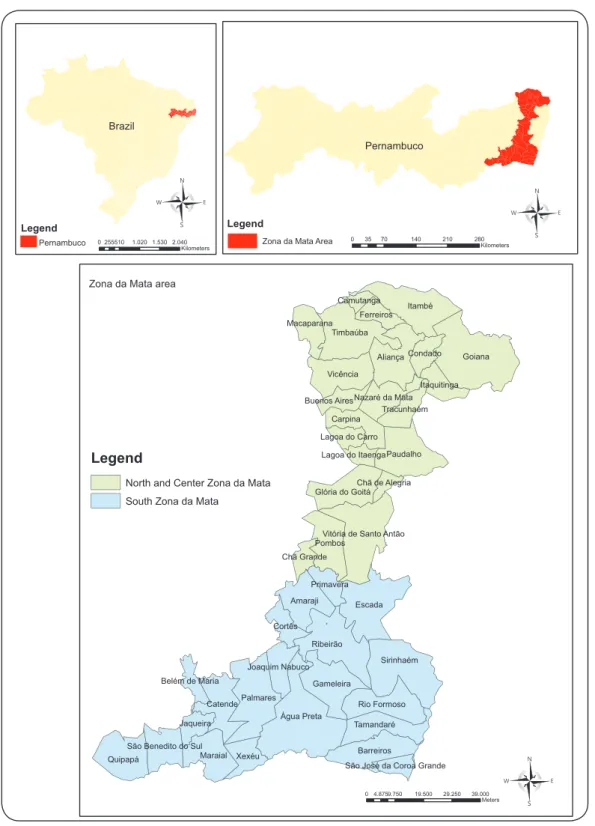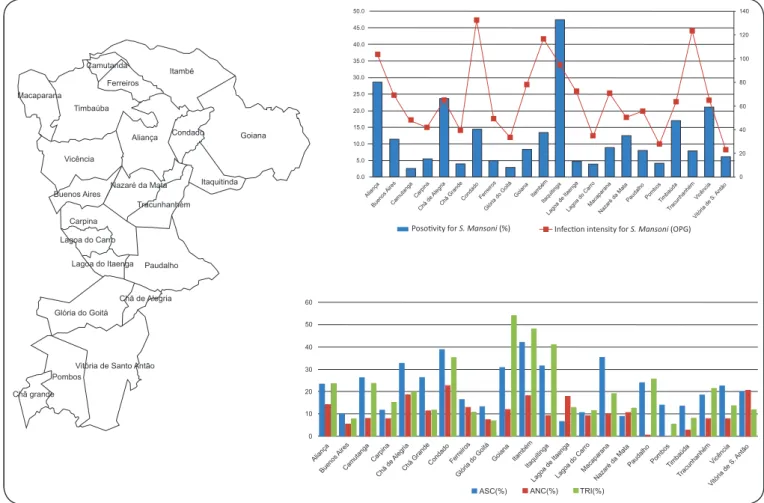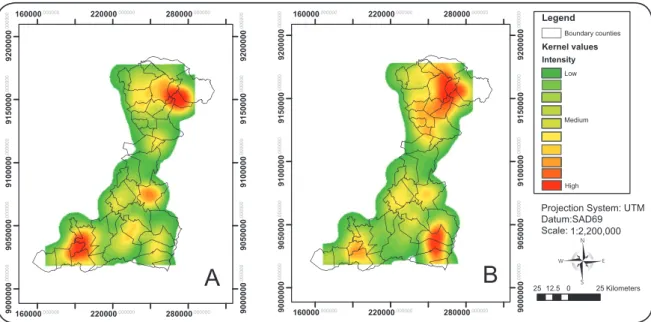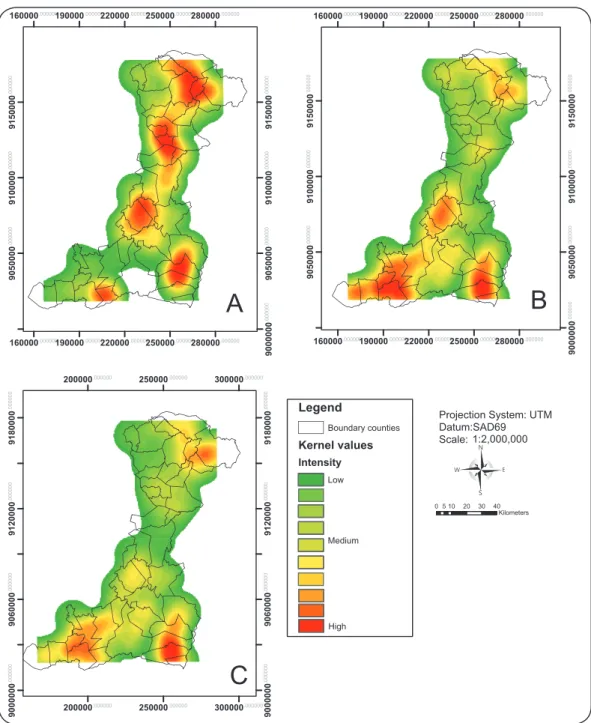INTRODUCTION
Address to: Dra. Verônica Santos Barbosa. Laboratório e Serviço de Referência em Esquistossomose/CPqAM/FIOCRUZ. Av. Moraes Rego s/n, Cidade Universitária, 50670-420 Recife, PE, Brazil.
Phone: 55 81 2101-2572
e-mail: sbveronica85@hotmail.com
Received in 16/02/2012
Accepted in 24/04/2012
Spaial distribuion of schistosomiasis and geohelminthiasis
cases in the rural areas of Pernambuco, Brazil
Verônica Santos Barbosa
[1], Karina Conceição Araújo
[1], Onicio Baista Leal Neto
[1]and Constança Simões Barbosa
[1][1]. Laboratório e Serviço de Referência em Esquistossomose, Centro de Pesquisas Aggeu Magalhães, Fundação Oswaldo Cruz, Recife, PE.
The prevalence and intensity of geohelminth infections and schistosomiasis remain high and it has been esimated that over 2 billion people worldwide (one third of the world’s populaion) may be infected by one or more parasites. Of these people, 300 million sufer from severe clinical forms of parasitosis and 155,000 die every year because of these diseases. Among the hundreds of helminth species that infect humans, Ascaris lumbricoides, Trichuris trichiura,
the hookworms Necator americanus and Ancylostoma duodenale and
Schistosoma ssp are the most frequent human parasites, and these have been correlated with high levels of morbidity and mortality¹.
One tool that has been used to ascertain variaions in occurrences of health problems in ime and space is geographical informaion systems (GIS)2-4. By means of maps, this tool makes it possible
to observe the spatial distribution of risk situations and health problems, thereby providing a panorama of environmental condiions of the populaion’s health5. Locaion and quaniicaion of spaial,
environmental and sociodemographic risks using GIS also enables planning of sanitary and health surveillance acions6.
An evaluaion made by Favre et al.7 on control acions against
schistosomiasis implemented in the State of Pernambuco by naional healthcare organizaions since 1977 showed that the situaion in the endemic area of the Zona da Mata of Pernambuco (ZMP) coninues to cause concern, despite apparent reductions in prevalence in
Major Article
ABSTRACT
Introducion: The prevalence and intensity of geohelminth infecions and schistosomiasis remain high in the rural areas of Zona da Mata, Pernambuco (ZMP), Brazil, where these parasites sill represent a signiicant public health problem. The present study aimed to spaially assess the occurrences of schistosomiasis and geohelminthiasis in the ZMP. Methods: The ZMP has a populaion of 1,132,544 inhabitants, formed by 43 municipaliies. An ecological study was conducted, using secondary data relaing to posiive human cases and parasite loads of schistosomiasis and posiive human cases of geohelminthiasis that were worked up in Excel 2007. We used the coordinates of the municipal headquarters to represent the ciies which served as the unit of analysis of this study. The Kernel esimator was used to spaially analyze the data and idenify distribuion paterns and case densiies, with analysis done in ArcGIS sotware.
Results: Spaial analysis from the Kernel intensity esimator made it possible to construct density maps showing that the northern ZMP was the region with the greatest number of children infected with parasites and the populaions most intensely infected by Schistosoma mansoni. In relaion to geohelminths, there was higher spaial distribuion of cases of Ascaris lumbricoides and Trichuris trichiura in the southern ZMP, and greater occurrence of hookworms in the northern/central ZMP. Conclusions: Despite several surveys and studies showing occurrences of schistosomiasis and geohelminthiasis in the ZMP, no prevenive measures that are known to have been efecive in decreasing these health hazards have yet been implemented in the endemic area.
Keywords: Schistosomiasis. Spaial analysis. Zona da Mata of Pernambuco.
the municipaliies. In a survey conducted by Barbosa et al.8 in the
ZMP, it was shown that there was an accumulated prevalence of schistosomiasis of 14.4%, and that for geohelminthiasis the prevalence was over 50% in some municipaliies, thus proving that these parasites are a relevant public health issue in this state. Hence, the present study aimed to spaially assess occurrences of schistosomiasis and geohelminthiasis in the ZMP, using GIS as an auxiliary tool, with the intenion of showing the epidemiological landscape of occurrences of these parasitoses, as a support for planning and applying efecive prevenion and control measures.
METHODS
Zona da Mata of Pernambuco occupies an area of 8,738km², which corresponds to 8.9% of the state’s territory, and has a populaion of 1,132,544 inhabitants, which is equal to 15.9% of the state’s populaion9. It is formed by 43 municipaliies and is considered to be
N
E W
S N
E W
S
N
E W
S
FIGURE 1 -Municipaliies of Zona da Mata, Pernambuco, Brazil. UTM: Universal Transverse Mercator.
The biological variables chosen for this study were: posiive human cases and parasite loads of schistosomiasis and posiive human cases of geohelminthiasis. An ecological study was conducted, using secondary data relaing to a survey conducted among schoolchildren aged 9-12 years living in the ZMP in 2005 were worked up. Was applied Kato-Katz coproscopic tests in the schoolchildren, being a total of 11,234 examinaions performed. The database was made available by the Schistosomiasis Laboratory and Reference Service of the Aggeu Magalhães Research Center (Centro de Pesquisa Aggeu Magalhães/
RESULTS
covers the region studied. The gradient level was controlled through selecing a parameter, known as bandwidth, which indicated the area to be considered in the calculaion and relected the geographical scale of the hypothesis of interest, along with the previous knowledge of the event studied. In the present study, over a radius of 17,500m around the centroid of each municipality, the following atributes were analyzed: I) prevalence of schistosomiasis; II) intensity of schistosomiasis infecion; III) prevalence of hookworm; IV) prevalence of trichuriasis; and V) prevalence of ascaridiasis. These analyses were performed in the ArcGIS (ArcInfo package, ESRI) environment, using Arc Tool Box > Spaial Analyst Tools > Kernel Density. Through smoothing, Kernel generated a density surface for visual detecion of event concentraions, i.e. agglomeraions over the space distribuion. The point distribuion was transformed into a coninuous risk surface for occurrences of schistosomiasis and geohelminthiasis11.
Poso�vity for S. Mansoni (%) Infec�on intensity for S. Mansoni (OPG)
To construct regional themaic maps, the ZMP was straiied into two categories: northern/central ZMP and southern ZMP.
The survey among schoolchildren conducted in 22 municipaliies in the northern/central ZMP covered 143 schools, and 6,532 individuals aged 9-12 years were examined, thus revealing mean posiivity of 12% for Schistosoma mansoni, and characterizing this area as presening a medium endemic level for schistosomiasis. The geometric mean of
FIGURE 2 -Posiivity and infecion intensity for Schistosoma mansoni and posiivity for geohelminth in school-children of North and Center Zona da Mata, Pernambuco, Brazil - February to March of 2005. ASC: Ascaris lumbricoides; ANC: Hookworms; TRI:Trichuris trichiura.
66.4 eggs per gram of feces (epg), suggests that the general situaion was one of mild infecion12. Figure 2 shows that in some municipaliies
in this region, such as Aliança, Buenos Aires, Chã de Alegria, Condado, Itambé, Itaquiinga, Nazaré da Mata, Timbaúba and Vicência, over 10% of the populaion was infected by S. mansoni and that some municipaliies had signiicant parasite load rates for this helminth, such as Aliança, Condado, Itambé and Tracunhaém. The northern/central ZMP showed medium endemicity, signiicantly for the geohelminths
Ascaris lumbricoides, hookworms and Trichuris trichiura (respecively, 21.8%, 10.8% and 20.1%).
In the southern ZMP, 21 municipaliies and 128 schools were sampled, and 4,703 schoolchildren were examined, showing mean posiivity of 17% for S. mansoni and geometric mean of 69.5 eggs per gram of feces (epg). Figure 3 shows some municipaliies with over 10% posiivity for schistosomiasis (Água Preta, Barreiros, Belém de Maria, Catende, Cortês, Escada, Gameleira, Jaqueira, Maraial, Palmares, Primavera, Quipapá, Ribeirão, Rio Formoso, São Benedito do Sul and Xexéu), and highlights that municipaliies such as Escada and Rio Formoso had infecion intensiies for S. mansoni that were higher than 50%. In relaion to the geohelminths, the mean prevalences for
A. lumbricoides, hookworms and T. trichiura (respecively 34.9%, 9.4% and 35.9%) indicate that there was a considerable risk of transmission and morbidity (Figure 3).
where the largest number of children infected with parasites and the schoolchild populaions most intensively infected by S. mansoni
were concentrated, and these are shown as red agglomeraions. The northern ZMP region stands out because of the larger number of schoolchildren with schistosomiasis and, moreover, it had the highest concentraion of parasite load for the helminth S. mansoni (Figure 4).
Poso�vity for S. Mansoni (%) Infec�on intensity for S. Mansoni (OPG)
In relaion to geohelminths, Figure 5 shows that the cases of hookworms were distributed throughout the ZMP, and it highlights that the spaial distribuion of cases of A. lumbricoides and T. trichiura
into the southern ZMP was greater.
N
E W
S
FIGURE 3 -Posiivity and infecion intensity for Schistosoma mansoni and posiivity for geohelminth in school-children of South Zona da Mata,
Pernambuco, Brazil - February to March of 2005. ASC: Ascaris lumbricoides; ANC: Hookworms; TRI: Trichuris trichiura.
FIGURE 4 -Spaial distribuion of prevalence (A) and infeccion intensity (B) for Schistosoma mansoni in Zona da Mata, Pernambuco, Brazil. UTM:
DISCUSSION
N
E W
S
FIGURE 5 -Spaial distribuion of Hookworms (A), Ascaris lumbricoides (B)and Trichuris trichiura (C) prevalence in Zona da Mata, Pernambuco, Brazil. UTM: Universal Transverse Mercator.
The results from this study show the worrying situaion among children living in rural areas of Pernambuco. It can be considered that the occurrence and prevalence diagnosed among schoolchildren in the ZMP is an underesimate, given that the survey performed in 2006 only took a single feces sample and that the diagnosic technique used (Kato Katz)13 did not allow detecion of occurrences of other helminths
(such as Strongyloides sp), or of protozoa.
Even with the limitaions menioned above, high parasite loads of S. mansoni were found among children living in the municipaliies of Escada, Rio Formoso, Aliança, Condado, Itambé and Tracunhaém. This deserves special atenion from the Schistosomiasis Control
Program (PCE), so that schoolchildren living at these locaions do not evolve to present severe and irreversible forms of schistosomiasis. Other municipalities did not present very high prevalence of
S. mansoni, but there were high rates of other types of geohelminthiasis in places such as Aliança, Chã de Alegria, Itaquitinga, Vicência, Água Preta, Catende, Escada, Gameleira and Jaqueira (all with mean prevalence of over 20%). This requires a more careful socioenvironmental and cultural diagnosis in order to understand the factors involved in the producion and maintenance of these high rates.
mobilizaion and health educaion. Data gathered by municipaliies relaing to posiive human cases of S. mansoni, case treatments and the breeding sites and vector mollusk foci detected should be input to the PCE informaion system (SISPCE) and be sent for consolidaion and analysis at central level, i.e. in the coordinaion oices of the PCE in each state. However, these data cannot be used as a reliable source of informaion, because the municipal localiies selected as sampling components for the informaion system do not obey staisical criteria and, therefore, they do not express the prevalence of the disease in the municipality and do not faithfully show the real schistosomiasis situaion in the State of Pernambuco.
According to Favre et al.7 in the reports generated by SISPCE, the
informaion on infecion rates due to A. lumbricoides and hookworms in municipaliies in Pernambuco is underesimated, according to the results from the various surveys that have been conducted in diferent localiies within the ZMP. In this manner, the preliminary results from the Naional Schistosomiasis and Geohelminthiasis Survey (N Katz: unpublished data), which is being conducted in Pernambuco, have shown that schoolchildren in the municipaliies of the northern ZMP, such as Vicência and Ferreiros, sill show worrying prevalence of A. lumbricoides, hookworms and T. trichiura, and also parasite loads for
S. mansoni of around 30 to 100epg.
Taking into consideraion the results discussed above, which express the health situation among schoolchildren in some municipaliies and localiies in Pernambuco, along with the observaion that it has been impossible for the PCE in Pernambuco to atain its goal of covering the endemic areas for schistosomiasis, we corroborate the proposiions of Favre et al.14 who showed that it is feasible to diagnose
and treat at least the school-age children in the ZMP.
Even though various surveys and studies over the last 30 years have shown occurrences of schistosomiasis and geohelminthiasis in the ZMP7,8,14,15 no prevenive measures are known to have been efecive in
the endemic area for decreasing the numbers of cases and morbidity due to these health hazards among schoolchildren in the ZMP.
REFERENCES ACKNOWLEDGMENTS
The authors declare that there is no conlict of interest. CONFLICT OF INTEREST
To the staf of Schistosomiasis Laboratory of the Research Center Aggeu Magalhães-Fundação Oswaldo Cruz.
1. Organização Pan Americana da Saúde. Quadro de Referência de um Programa Regional para o Controle das Geohelmintoses e Esquistossomíase na América. Santo Domingo, República Dominicana: OPS/DPC/CD/318/04; 2003.
2. Campos MR, Valencia LIO, Fortes BPMD, Braga RCC, Medronho RA. Distribuição espacial da infecção por Ascaris lumbricoides. Rev Saude Publica 2002; 36:69-74. 3. Fonseca EOL, Teixeira MG, Barreto ML, Carmo EH, Costa MCN. Prevalência e fatores associados às geo-helminíases em crianças residentes em municípios com baixo IDH no Norte e Nordeste brasileiros. Cad Saude Publica 2010; 26:143-152. 4. Paredes H, Souza-Santos R, Resendes APC, Souza MAA, Albuquerque J, Bocanegra
S. et al. Spaial patern, water use and risk levels associated with the transmission of schistosomiasis on the north coast of Pernambuco, Brazil. Cad Saude Publica 2010; 26:1013-1023.
5. Araujo KCGM, Resendes APC, Souza-Santos R, Silveira Júnior JC, Barbosa CS. Análise Espacial dos Focos de Biomphalaria glabrata e de casos humanos de esquistossomose em Porto de Galinhas, Pernambuco. Cad Saude Publica 2007; 23:409-417.
6. Barcellos C, Couinho K, Pina MF, Magalhães MMAF, Paola JCMD, Santos SM. Inter-relacionamento de dados ambientais e de saúde: análise de risco à saúde aplicada ao abastecimento de água no Rio de Janeiro uilizando Sistemas de Informações Geográicas. Cad Saude Publica 1998; 14:597-605.
7. Favre TC, Pieri OS, Barbosa CS, Beck L. Avaliação das ações de controle da esquistossomose implementadas entre 1977 e 1996 na área endêmica de Pernambuco, Brasil. Rev Soc Bras Med Trop 2001; 34:569-576.
8. Barbosa CS, Favre TC, Wanderley TN, Callou AC, Pieri OS. Assessment of schistosomiasis, through school surveys, in the Forest Zone of Pernambuco, Brazil. Mem Inst Oswaldo Cruz 2006, 101:55-62.
9. Insituto Brasileiro de Geograia e Estaísica (IBGE). Censo 2000 [Internet]. IBGE; 2000 [updated 2011 September 12, cited 2011 Ocotber 5]. Available from: htp:// www.ibge.gov.br/home/estaisica/populacao/censo2000/default.shtm 10. Jansen W, Mafra R. A Zona da Mata de Pernambuco [Internet]. Brasil (PE):
Âncora; 2010 [cited 2011 October 10]. Available from: htp://www.ancora.org. br/textos/011_jansen-mafra.html.
11. Bailey TC, Gatrell AC. Interacive spaial data analysis. Harlow: Longman; 1995. 12. World Health Organizaion. Report of a WHO Expert Commitee. Prevenion and
Control of Schistosomiasis and the Soil-transmited Helminthiasis. Geneva: WHO Library; 2002.
13. Katz N, Chaves A, Pellegrino JA. Simple Device for Quanitaive Stool Thick-smear Technique in Schistosomiasis Mansoni. Rev Inst Med Trop São Paulo 1972; 14:397-400. 14. Favre TC, Ximenes RAA, Galvão AF, Pereira APB, Wanderlei TN, Barbosa CS, et al. Reliability of current esimates of schistosomiasis prevalence in the Rainforest Zone of the state of Pernambuco, Northeastern Brazil. Mem Inst Oswaldo Cruz 2006, 101:73-78.
15. Zani LC, Favre TC, Pieri OT, Barbosa CS. Impact of anihelminthic treatment on infecion by Ascaris lumbricoides, Trichuris trichiura and hookworms in Covas, a rural community of Pernambuco, Brazil. Rev Inst Med Trop São Paulo 2004, 46:63-71. ABSTRACT IN pORTUGUESE
Distribuição espacial dos casos de esquistossomose e geohelmintoses em áreas rurais de Pernambuco, Brasil
Introdução: A prevalência e intensidade das infecções produzidas por geohelmintos e esquistossomose coninuam elevadas na Zona da Mata de Pernambuco (ZMP), onde essas parasitoses se apresentam como relevante problema de saúde pública. O presente estudo objeivou espacializar a ocorrência da esquistossomose e geohelmintoses na ZMP. Métodos: A ZMP apresenta uma população de 1.132.544 habitantes, composta por 43 municípios. Um estudo ecológico foi desenvolvido, uilizando dados secundários referentes aos casos humanos posiivos e cargas parasitárias para esquistossomose e casos humanos posiivos para geohelmintoses que foram trabalhados no Excel 2007. Foram uilizadas as coordenadas das sedes municipais para representar o município o qual serviu de unidade de análise deste estudo. Para análise espacial dos dados e ideniicação de padrões de distribuição e densidade dos casos, foi adotado o esimador de Kernel, sendo as análises feitas no sotware ArcGIS. Resultados: A análise espacial, a parir do esimador de intensidade de Kernel, permiiu a construção de mapas de densidade mostrando a Mata Norte como a região onde se concentra o maior número de crianças parasitadas e as populações mais intensamente infectadas pelo Schistosoma mansoni. Com relação aos geohelmintos, há uma maior distribuição espacial
dos casos de Ascaris lumbricoides e Trichuris trichiura na Mata Sul, destacando a maior ocorrência de ancilostomídeos entre as Matas Norte e Centro de Pernambuco. Conclusões: Apesar dos inquéritos e dos vários estudos mostrando a ocorrência de esquistossomose e geohelmintoses na ZMP ainda se desconhecem medidas prevenivas que tenham sido implementadas na área endêmica mostrando efeividade na redução destes agravos.



